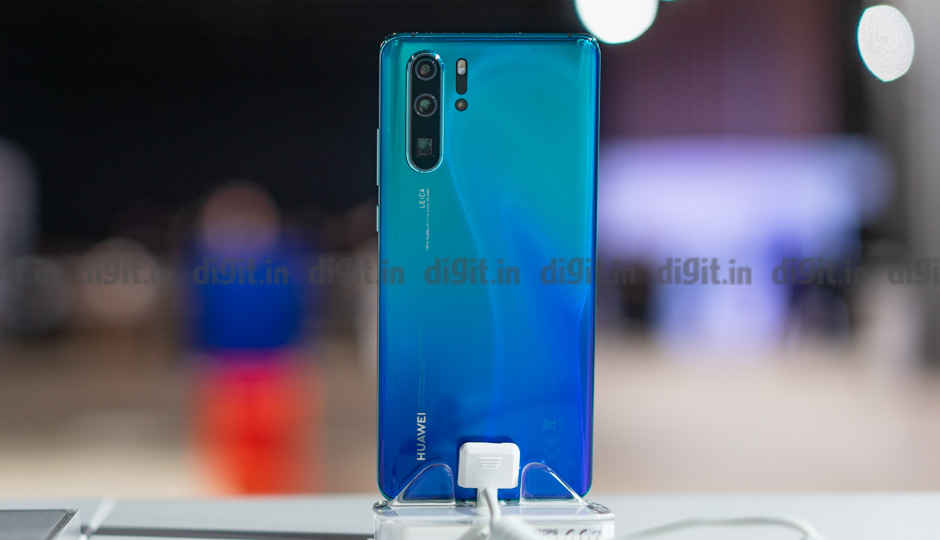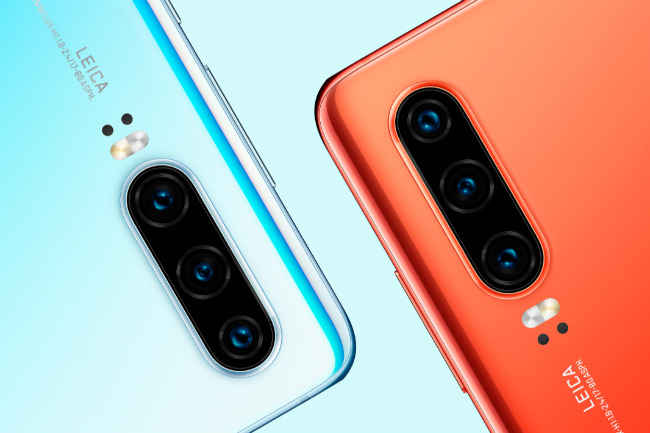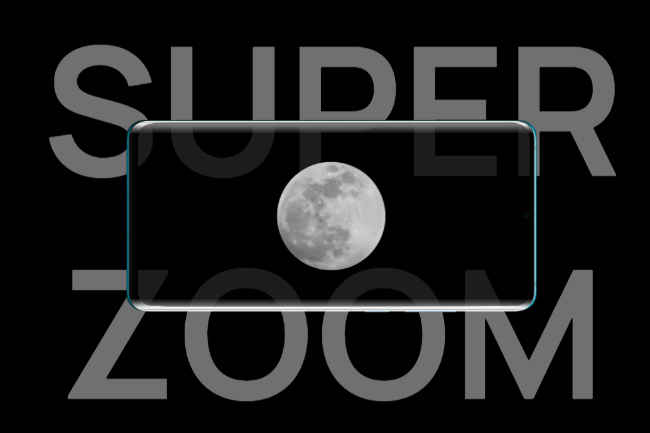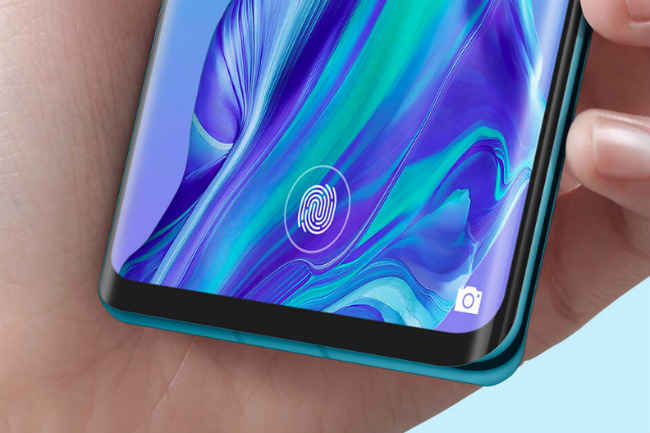Huawei P30 Pro with Leica Quad camera system, P30 with three cameras launched
Both the Huawei P30 and the P30 Pro come with a 1/1.7-inch Huawei SuperSpectrum Sensor with RYYB Bayer filter where the green pixels are replaced with yellow pixels allowing for 40 percent more light capture.

Highlights:
 Survey
Survey- Huawei launches P30 and P30 Pro phones.
- Both the phones have SuperSpectrum Sensor with RYYB Bayer filters.
- The P30 Pro offers a 3X optical zoom, 5X hybrid zoom and 50X times digital zoom.
After weeks of leaks and reports, Huawei has finally launched the Huawei P30 and P30 Pro smartphones at an event at the Paris Convention Center, France. As expected, the phones are aimed at “Rule breaking photography” and “powerful videography.” The Chinese tech giant says that the Huawei P30 Series devices are the company’s most advanced camera smartphones to date and rival professional cameras. The phones come with SuperSpectrum Sensor, an optical SuperZoom lens, a new Time of Flight (TOF) camera. The lenses are claimed to have better OIS and AIS image stabilisation technology.
“The latest Huawei P30 Series represents a breakthrough after decades of digital camera technology development that will rewrite the rules and reshape the perception that consumers have of mobile photography. Innovations such as the Huawei SuperSpectrum Sensor and SuperZoom Lens allow us to push the envelope of not just photography, but videography as well – a frontier long overdue for disruption. The Huawei P30 Series will set the pace for the next several generations of smartphones,” Richard Yu, CEO of Huawei Consumer BG, said.
Camera
The Huawei P30 is equipped with a Leica Triple camera system, including a 40MP main camera with SuperSpectrum Sensor and lens having f1.8 aperture, a 16MP ultra-wide angle camera with f2.2 aperture and an 8MP telephoto camera with f2.4 aperture. On the front is the 32MP camera with AI HDR+. The Huawei P30 Pro, on the other hand, comes with a Leica Quad camera setup, including a 40MP main camera with lens having f1.6 aperture, a 20MP ultra-wide angle camera with f2.2 aperture, an 8MP telephoto camera with 5X Telephoto lens (f3.4 aperture) and a Time-of-Flight (TOF) camera, along with a 32MP front camera with AI HDR+.
As mentioned, both the phones come with a 1/1.7-inch Huawei SuperSpectrum Sensor which has a different Bayer filter than the standard ones. Unlike the traditional sensors that have RGBG Bayer filter, the SuperSpectrum Sensor has the RYYB filter where the green pixels are replaced with yellow pixels. Huawei claims that this lets the sensor capture 40 percent more light and yields a high maximum ISO rating of 204,800 and 409,600 on the Huawei P30 and Huawei P30 Pro respectively.
The Huawei SuperZoom Lens supports 3X optical zoom, 5X hybrid zoom and 50X times digital zoom on the P30-Series phones (30X on P30) , which it achieves through a periscope design. A prism element in the telephoto camera bends light at a right angle and sends it to a cluster of lenses to achieve variant focal length. Both the phones have AIS and OIS, which are claimed to deliver brighter images in low light conditions and steady shot when clicking an image through a telephoto lens. Both the phones have flash, colour temperature and flicker sensors, however, the P30 comes with additional Laser transmitter and laser receiver.
Huawei says that the camera on the devices can capture videos in 4K quality at 60fps. The phone has an AI Movie Editor that is said to automatically identify action highlights and suggest the tools to add background music and special effects. Moreover, the phones come with a Dual-View mode in which, the phones use two of the rear cameras to record different videos using an ultra-wide angle clip and a zoom shot at the same time. The P30 Pro camera has scored 112 points on DXOMark making it the first phone to achieve this high rating.
Display
The company notes that the P30 Series design is inspired by nature. The P30 sports a 6.1-inch Full HD+ OLED panel (DCI-P3 HDR display) offering a resolution of 2340×1080 pixels, and a 19.5:9 aspect ratio owing to the waterdrop notch. On the other hand, the Huawei P30 Pro features 6.47-inch Full HD+ Curved OLED display (DCI-P3 HDR) with a 2340×1080 pixels resolution, and an aspect ratio of 19.5:9 aspect ratio.
The phone is launched in Amber Sunrise, Pearl White, Aurora, Black and special Breathing Crystal colours. On the back, both phones are said to come with nine layers of Nano Optical colour finish on the back panel. The Huawei P30 Pro also features the Acoustic Display Technology, which is basically an in-screen maglev speaker for earpiece audio (the Huawei P30 has a regular earpiece). Both the phones run EMUI 9.1 baked atop Android 9 Pie. The latest OS also supports Apple’s AirDrop like Huawei Share OneHop for file sharing between Huawei phones and PCs.
Hardware
Under the hood, the P30 and the P30 Pro have 7nm Kirin 980 processors with a Dual-NPU, however, there is a difference in RAM and storage variants. The P30 is offered only with 6GB RAM and 128GB storage, while the P30 Pro is offered in three variants: 8GB RAM and 128GB storage, 8GB RAM and 256GB storage and 8GB RAM and 512GB storage. Both the phones have graphene film cooling system to manage the device temperatures. The P-Series of phones come with in-display optical fingerprint sensors and the company claims that this sensor is 30 percent faster than the previous generation ones.
When it comes to battery, the P30 Pro features 4,200mAh pack with reverse wireless charging feature. The Pro variant supports 40W fast charging and 15W wireless charging. The P30 ships with 3,650mAh battery with 25W fast charging support, but has no wireless charging. The Pro variant has an IP68 rating, and the standard one comes with IP53 rating.
Price
While, the Huawei P30 is priced at 799 euros (approx Rs 62,200), the Pro variant starts at a price of 999 euros (approx Rs 78,000) for the 128GB storage variant. The 256GB and 512GB storage variants are priced 1099 euros (approx Rs 85,600) and 1249 euros (approx Rs 97,000).
Digit NewsDesk
Digit News Desk writes news stories across a range of topics. Getting you news updates on the latest in the world of tech. View Full Profile


